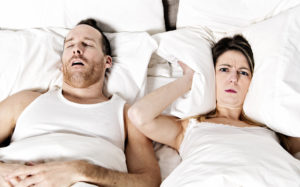
There is a physical reason why people snore. The same physical components also cause some children to snore as well as some breeds of dogs or cats. 
Snoring is a vibration that occurs in your throat caused by a narrowing of the upper airway. Snoring can be prompted by a number of factors, including structural makeup, age, alcohol consumption, allergies, a cold, and being overweight.
However, the actual cause is from the relaxation during sleep of the muscles in the soft palate (back portion of the roof of the mouth), tongue, and throat.
Snoring can be rather mild and sporadic. A number of people who snore do so when they lie on their backs. In this position, the base of your tongue and soft palate collapse to the back of the throat, leading to a vibration sound.
Yet, sleeping on the side may not be a solution if your snoring is due to a sleep disorder.
Heavy snoring is often a telltale sign of obstructive sleep apnea (OSA). Sleep apnea has severe, even deadly, side effects and is coming to light as one of the nation’s most concerning health conditions among adults in the U.S.
What is sleep apnea?
Sleep apnea translates to “pauses” in breathing during sleep. These pauses can occur hundreds of times each night, with each lasting for up to a minute. Imagine holding your breath for up to a minute several times each hour during the day? This is what a sleep apnea sufferer endures throughout the night.
For people who have sleep apnea, night-time slumber is anything but restful. The penalty they pay during awake hours includes fatigue, lack of alertness, reduced energy, nodding off easily, feeling hungry more often, and being more accident prone.
As depleting as these symptoms are, many people are unaware of the serious side effects associated with sleep apnea. The deprivation of sufficient oxygen to the brain and heart heightens the risks of severe health problems. These include heart disease, stroke, high blood pressure, obesity, and Type 2 diabetes.
Restful sleep should be just that – RESTFUL. The sleep process enables our brain’s to reset hormonal balances and sweep out toxins. Struggling to take in oxygen during the night leaves us without sufficient REM sleep (that deep sleep that is so vital to this process).
It is now estimated that 26 percent of adults between the ages of 30 and 70 have sleep apnea. That’s pretty scary, when you factor in that, according to the CDC:
“The National Highway Traffic Safety Administration estimates that drowsy driving was responsible for 72,000 crashes, 44,000 injuries, and 800 deaths in 2013. However, these numbers are underestimated and up to 6,000 fatal crashes each year may be caused by drowsy drivers.” https://www.cdc.gov/features/dsdrowsydriving/index.html
The reasons for treating heavy snoring and sleep apnea go on and on. However, how do people know if they suffer from sleep apnea?
For people who sleep alone, or those sleeping next to sound sleepers (who don’t always notice their bedmate’s breathing patterns), how might this come to light? Or, for those who have sleep apnea and make no noise at all during sleep?
A recent article in the New York Times addresses this, and more: https://www.nytimes.com/2019/05/27/well/mind/sleep-apnea-can-have-deadly-consequences.html
With the apparent prevalence among American adults and the health risks, there is growing publicity surrounding sleep disorders. Yet, as the New York Times’ article points out, “as many as 9 in 10 adults with this treatable condition remain undiagnosed.”
A sleep study can establish this, as well as determine its severity (if it does exist). However, a sleep study is not always easy. This used to require spending the night in a sleep lab. While an effective means of establishing the disorder, sleeping in a foreign bed while hooked up to measurement devices has been a deterrent for some people.
For these people, at-home sleep studies can now be performed while the adult is at home in his/her own bed. At-home studies have shown to be effective, affordable, and are mailed right to the residence. Once testing is completed, the device is mailed back for reading by a sleep physician. Some insurance companies even cover the cost of the testing process.
Regardless of how you are tested, it is paramount that sleep apnea is addressed without delay. This disorder will not go away on its own, or improve. If you are known to snore heavily, early testing can help you minimize related health risks AND restore your energy, alertness and motivation levels during the day.
Early diagnosis can also minimize treatment needs. When caught before sleep apnea reaches a “severe” level, a small, comfortable oral appliance worn during sleep may be all that’s needed. Our FDA-approved devices are custom-fitted to each mouth.
In our Shelby Township, MI dental office, we also use low-radiation Cone Beam imaging to factor all considerations of airways passages. This enables us to tailor each device and usage protocols to accommodate individual structures.
We have a number of people with sleep apnea who come to our Michigan dental office from all across Macomb and Oakland county, and even further out. We are known for taking a unique approach to each patient’s situation and incorporating follow-up that helps to provide optimal results.
If you snore or suspect your sleep quality is less-than-refreshing, call our Shelby Twp dental practice at 586-739-2155 to learn more, or tap here to request a no-charge private session. Together, we’ll discuss your specific needs and the thorough diagnostic process that can reveal, or rule out, sleep apnea.